
Yesterday, E & Baby R went out for a walk in the woods with Daddy & our dog. They had a fine time & E brought a flower back for me. She looked it up in the field guide when she got home (& found it, all by herself!) & we found it to be a 'Lesser Celandine' She then helped me to press it, so it can go into my nature notebook.
Lesser celandine
Scientific classification
Kingdom:
Plantae
Division:
Magnoliophyta
Class:
Magnoliopsida
Order:
Ranunculales
Family:
Ranunculaceae
Genus:
Ranunculus
Species:
R. ficaria
Binomial name
Ranunculus ficariaL.
Lesser celandine, (Ranunculus ficaria, syn. Ficaria grandiflora Robert Ficaria verna Huds.) is a low-growing, hairless perennial plant, with fleshy dark green, heart-shaped leaves.
According to Gilbert White, a diarist writing around 1800 in the Hampshire village of Selborne, the plants came out on February 21st, but it is more commonly reported to flower from March until May, and is sometimes called the "spring messenger" as a consequence. The flowers are yellow, turning white as they age. Ranunculus ficaria exists in both diploid (2n=16) and tetraploid (2n=32) forms which are very similar in appearance. However, the tetraploid type prefer more shady locations and frequently develops bulbils at the base of the stalk. These two variants are sometimes referred to as distinct sub-species,R. ficaria ficaria and R. ficaria bulbifer respectively. The plant is found throughout Europe and west Asia and is now introduced in North America. It prefers bare, damp ground and in the UK it is often a persistent garden weed.
The plant used to be known as Pilewort, as it was used to treat haemorrhoids. Supposedly the knobbly tubers of the plant resemble piles, and according to the Doctrine of signatures this resemblance suggests that pilewort could be used to cure piles. The German vernacular Scharbockskraut (Scurvywort) derives from the use of the early leaves, which are high in vitamin C, against scurvy.
Lesser celandine flower
The poet William Wordsworth was very fond of the flower and it inspired him to write three poems including the following from his ode to the celandine:
I have seen thee, high and low,
Thirty years or more, and yet
T'was a face I did not know.
Upon Wordsworth's death it was proposed that a celandine be carved on his memorial plaque inside the church of Saint Oswald at Grasmere, but unfortunately the Greater celandine Chelidonium majus was mistakenly used.
In many parts of the northern United States and Canada, lesser celandine is invasive.
Lesser celandine
Scientific classification
Kingdom:
Plantae
Division:
Magnoliophyta
Class:
Magnoliopsida
Order:
Ranunculales
Family:
Ranunculaceae
Genus:
Ranunculus
Species:
R. ficaria
Binomial name
Ranunculus ficariaL.
Lesser celandine, (Ranunculus ficaria, syn. Ficaria grandiflora Robert Ficaria verna Huds.) is a low-growing, hairless perennial plant, with fleshy dark green, heart-shaped leaves.
According to Gilbert White, a diarist writing around 1800 in the Hampshire village of Selborne, the plants came out on February 21st, but it is more commonly reported to flower from March until May, and is sometimes called the "spring messenger" as a consequence. The flowers are yellow, turning white as they age. Ranunculus ficaria exists in both diploid (2n=16) and tetraploid (2n=32) forms which are very similar in appearance. However, the tetraploid type prefer more shady locations and frequently develops bulbils at the base of the stalk. These two variants are sometimes referred to as distinct sub-species,R. ficaria ficaria and R. ficaria bulbifer respectively. The plant is found throughout Europe and west Asia and is now introduced in North America. It prefers bare, damp ground and in the UK it is often a persistent garden weed.
The plant used to be known as Pilewort, as it was used to treat haemorrhoids. Supposedly the knobbly tubers of the plant resemble piles, and according to the Doctrine of signatures this resemblance suggests that pilewort could be used to cure piles. The German vernacular Scharbockskraut (Scurvywort) derives from the use of the early leaves, which are high in vitamin C, against scurvy.
Lesser celandine flower
The poet William Wordsworth was very fond of the flower and it inspired him to write three poems including the following from his ode to the celandine:
I have seen thee, high and low,
Thirty years or more, and yet
T'was a face I did not know.
Upon Wordsworth's death it was proposed that a celandine be carved on his memorial plaque inside the church of Saint Oswald at Grasmere, but unfortunately the Greater celandine Chelidonium majus was mistakenly used.
In many parts of the northern United States and Canada, lesser celandine is invasive.
Sunrise:6.16
Sunset:18.21
No comments:
Post a Comment